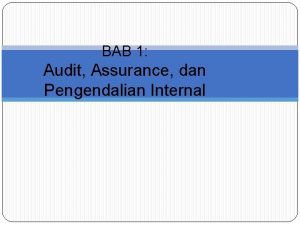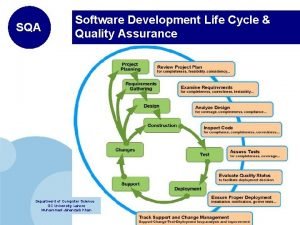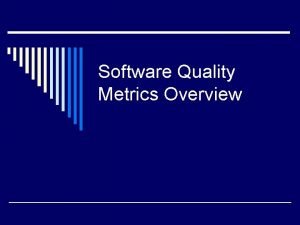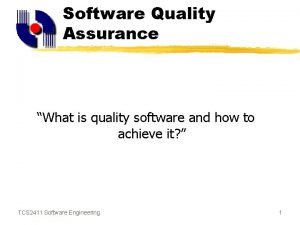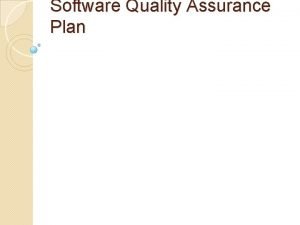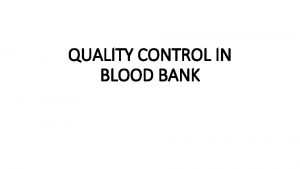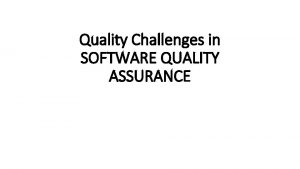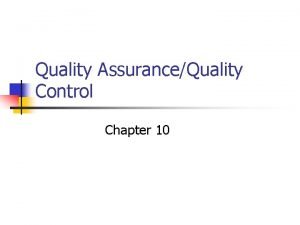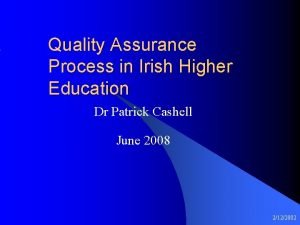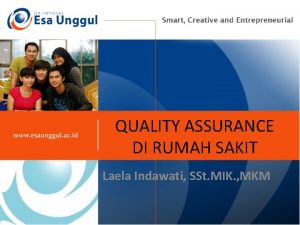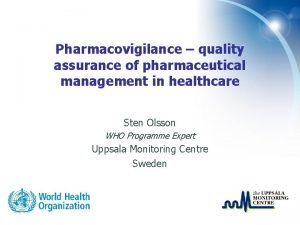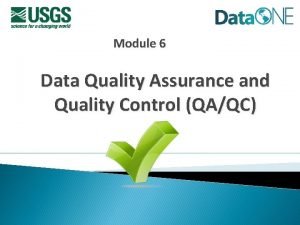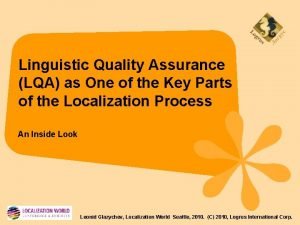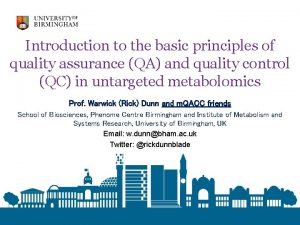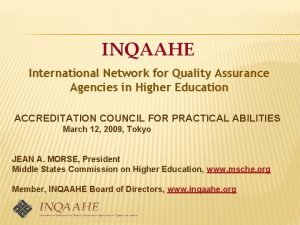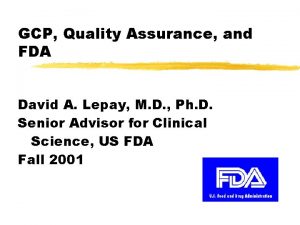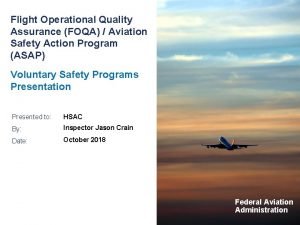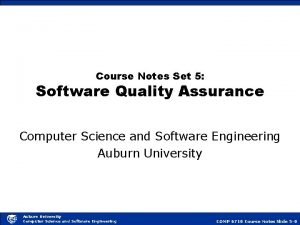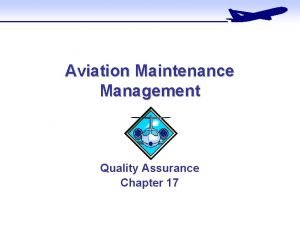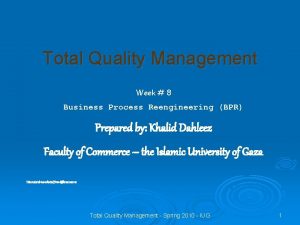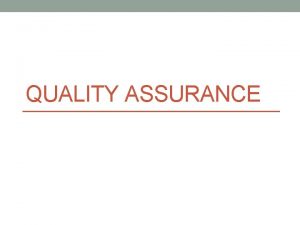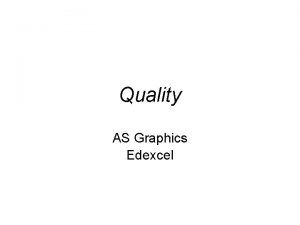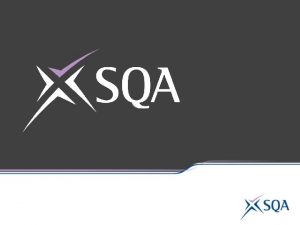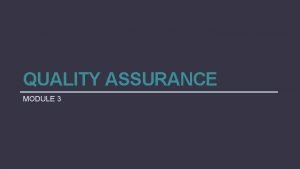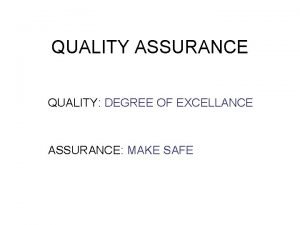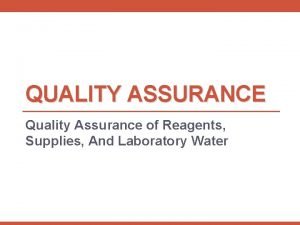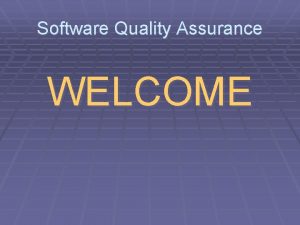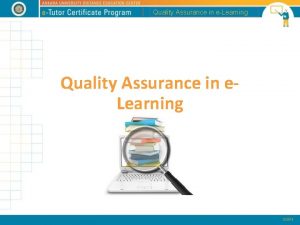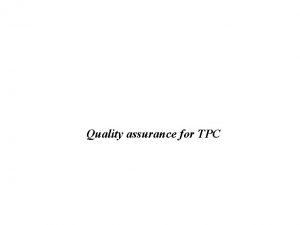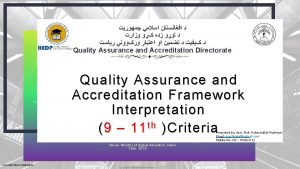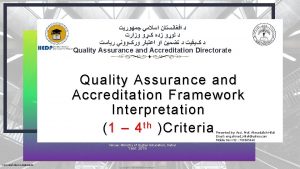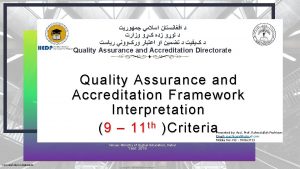INTERNAL QUALITY ASSURANCE OF STUDY PROGRAMMES IN THE
































- Slides: 32

INTERNAL QUALITY ASSURANCE OF STUDY PROGRAMMES IN THE SLOVAK REPUBLIC n Slovak University of Technology in Bratislava n Faculty of Civil Engineering n Eva Jankovichová n Kazachstan, Astana, August 2012

Slovak Higher Education System n According to Act No. 131/2002 Coll. , on Higher Education and on Change and Supplement to Some Laws n implements all components of the Bologna Declaration - three levels that implement the credit system for assessment n is provided through the accredited study programmes Source: [1] http: //www. astu. tuke. sk/dokumenty/L_131. pdf

Slovak Higher Education System The Ministry of Education in cooperation with the Higher Education Institutions defined the list of the fields of study for higher education; the accredited study programme may be carried out exclusively in the field of study which has been included in the list of the fields of study. Source: [2] http: //www. minedu. sk/index. php? lang=en&root. Id=25

Slovak Higher Education Institutions (HEIs) ● are autonomous and self-governing ● the Act on Higher Education defines the area of competence of various self-governing bodies ● HEIs are divided into: - professional-type (21) and university-type (18) - public (20), state (3), private (12), foreign (4)

Slovak Higher Education Institutions (HEIs) The representative bodies are: ● Slovak Rectors’ Conference (association of university rectors) ● Higher Education Council (its bodies are elected by the academic senates of HEIs) ● Student Higher Education Council (members are elected by the student parts of the academic senates ) Source: [3] http: //www. minedu. sk/index. php? lang=en&root. Id=17

The System of Quality Assurance is based on: - internal quality assessment - external evaluation - accreditation

The Accreditation Commission (AC) is established by law n is an advisory body of the Government of the Slovak Republic - does not make decisions, but has the position of an independent professional body that issues standpoints and recommendations n AC carries out accreditation of individual activities of HEIs - carries out regular complex accreditation of all HEIs in six-year intervals n

The Accreditation Commission (AC) ■ it gives its opinion on capacity of the higher education institution to: - implement the study programme with the right to award to its graduates the academic degree, In the accreditation of the study programme, an assessment is carried out of the curriculum, student profile, applicant requirements, selection of students, graduation requirements, personnel, material, technical and information provision for the programme, and the educational level of graduates and students of the programme.

The Accreditation Commission (AC) ■ it gives its opinion on capacity of the higher education institution to: - proposal for granting the State consent for a legal entity wishing to act as a HEI, - to conduct the habilitation procedure and procedure for nomination of professors, - proposals of establishment, merger, affiliation, split, dissolution, change of name or change of seat ,

The Accreditation Commission (AC) ■ it gives its opinion on capacity of the higher education institution to: - proposal for classification of higher education institutions as research universities, universities and professional higher education institutions, - proposal for change in the system of fields of study, - other proposals with regard to the system of higher education presented by the Minister.

The Accreditation Commission (AC) ■ is a member of: ENQA, INQAAHE , CEENQAAHE ■ all outcomes of the AC’s activities are publicly available on its website Source: [6] http: //www. akredkom. sk/en/

Strengths and Weaknesses of AC Strengths: ■ The system of accreditation in the Slovak Republic has a history of more than twenty years. - The activities of the AC and accreditation of the fields of study were regulated by law as early as the 1990 s. n The AC has a strong position in quality assurance and evaluation of the activities of the HEIs.

Strengths and Weaknesses of AC ■ Clear rules - Substantial portion of the work performed by the AC is regulated by legal rules, the rules are transparent and generally known. ■ International activities - Membership of the AC in international organizations. ■ Regular verification - The system of complex accreditations, is an instrument that has been introduced to assure that HEIs continue to fulfill the required attributes and maintain the required standards.

Strengths and Weaknesses of AC Weaknesses: ■ Broad scope of decisions - Members of the AC give their viewpoints on applications concerning all groups of SPs. A member of the AC is able to assess most requests formally, rather than professionally. This deficiency is, compensated by the working groups which specialize in individual study fields, or in groups of related study fields. ■ Financial provision - The AC’s work is financed from the state budget, the financing of the Commission depends on the AC members having another (full-time) job and their AC work is performed outside their main jobs.

Strengths and Weaknesses of AC ■ Information sources - The background materials used by the AC for its activities are prepared by the HEIs. The procedures require time-consuming provision of information, some of which is not relevant to the conclusions reached by the AC. ■ The AC gives its standpoint - The AC gives its standpoint, on the basis of which the Minister of Education decides to grant a right to a higher education institution. The AC is not directly responsible, as the final decision is taken by the Minister.

Strengths and Weaknesses of AC ■ Highlighting the importance of guarantors of SP at the expense of other criteria - individual university teaching staff members started working at more than one institution, and this is considered today as a weakness of the higher education system (the university teaching staff should also be involved in research) ■ The internal system of control - quality of provision of educational activities, and also of research activities, can be expressed through various attributes, (e. g. , the material-technical equipment for providing a programme in nuclear physics will differ substantially from the equipment needed for the study of law)

Strengths and Weaknesses of AC ■ Requirements for selection of members and their position - A requirement for proposals of members of the AC is that candidates for membership may be from among distinguished personalities at HEIs, or at the Slovak Academy of Sciences, or other scientific and professional establishments, including also foreign establishments (limits the possibility to propose a member who represents the employers).

Strengths and Weaknesses of AC Both Strengths and Weaknesses: ■ Members of the AC are appointed by the Government of the Slovak Republic - The negative aspect is that this linkage may also weaken the independence of the AC. The nominations to the AC are dependent on statements from the representative bodies of HEIs (conflict of interests). - Every two years, the term of office of one third of the members of the AC expires.

Strengths and Weaknesses of AC ■ The Accreditation Commission uses uniform criteria - Uniform, well-known, predictable criteria according to which the HEIs are to be assessed, contribute positively to the preparation of HEIs for the accreditation procedure. - The individual procedures are transparent and impartial. This philosophy brings together the missions of higher education institutions and graduates’ profiles and pushes them in a uniform direction, Source: [8] Studies on Higher Education Implementation of the Standards and Guidelines for Quality Assurance in Higher Education in the Central and East-European Countries – Agenda Ahead by Jan KOHOUTEK (Editor) Bucharest 2009, ISBN 92 -9069 -189 -1 © UNESCO 2009.

External evaluation of HEIs • Home Agency ARRA - Academic Ranking and Rating Agency is an independent Slovak civil association Source: http: //arra. sk/english • Foreign Agency Webometrics Ranking of World Universities - the largest public research body in Spain Source: [4] http: //www. webometrics. info/ http: //www. sav. sk/index. php? lang=sk&charset=&doc=services-news&source_no=20&news_no=4388

Internal Quality Assurance ● The Act on Higher Education stipulates that the HEIs shall also be concerned with quality of teaching as well as their research and creative activities. ● Within the framework of complex accreditation, the HEIs also submit an evaluation of their own activities to the AC. ● The Scientific Council of the HEI has the responsibility at least once a year to evaluate the level of the educational activities and activities in the field of science, technology or art at the HEI (visitation).

Internal Quality Assurance ● The students have the right to give their standpoint on the quality of teaching and on individual teaching staff members in the form of anonymous questionnaires at least once a year. ● HEIs and their departments make use of selfevaluation for development purposes and in order to identify threats. ● The results of these evaluations are not usually published. The assessment reports prepared for the AC by its working groups are made available only to the higher education institution concerned and to the Ministry of Education.

Internal Quality Assurance n Beyond the framework of the Act, some higher education institutions have been awarded quality certificates according to the ISO quality norms (e. g. , Slovak University of Technology in Bratislava, Faculty of Civil Engineering, University of Technology in Košice), or they implement/introduce the Common Assessment Framework (CAF) system within the framework of the higher education institution or its departments. Source: [5] GAŠPARÍK, J. : Quality Management System of Educational Process. Bratislava: Slovak University of Technology, Faculty of Civil Engineering, Bratislava 2009, 13 pp.

Internal Quality Assurance Challenges ■ Broad schemes for organizing internal quality assurance policies can be found at all HEIs in questionnaires and databases, along with selfevaluation reports (for complex evaluation) figure among the major implementation instruments. ■ Institutional quality assurance policies are still more based on inputs (staff qualifications, infrastructure) than outputs (such as learning outcomes).

Internal Quality Assurance Challenges ■ The quality of higher education institutions’ activities is assessed externally by the AC. At the moment, however, there is no interconnection between the internal quality assurance instruments of the institution and the external assessment of quality by the AC. ■ It is not the basic task of external assessment to assess the instruments used for internal quality assurance and improvement.

Internal Quality Assurance Challenges Policies on quality assurance can be identified as follows: ● Heavily top-down oriented implementation style. The very top-down orientation of internal quality assurance policies may be the barrier to their effective implementation in traditionally decentralized institutional settings.

Internal Quality Assurance Challenges Policies on quality assurance can be identified as follows: ● Strong external impact of accreditation measures. Still predominantly input-oriented accreditation procedures - especially staff qualifications – as proxies for quality of educational activities applicable for research and development purposes.

Internal Quality Assurance Challenges Policies on quality assurance can be identified as follows: ●Reactive policy-making, based on the plethora of mandatory administrative (policy) documents. Conducive to formal adoption of goals and missing “follow-through” measures.

Internal Quality Assurance Challenges ■ Improving the internal mechanisms of quality assurance within the HEIs is a key task for further development of the whole system of higher education. ■ Lack of formalization, objectification and evaluation of the efficiency of individual instruments of internal quality assurance are the greatest shortcomings in terms of ESG implementation, though it should be added that the situation varies to a remarkable extent from institution to institution and even from faculty to faculty.

Internal Quality Assurance Challenges ■ The national policy, stipulating that all HEIs must perform internal evaluations and make the results public, is understandably rather general, giving HEIs a leeway for implementing internal policies in line with their profile, needs, and development preferences. ■ In future, it will be necessary to address especially the question of developing internal quality assurance mechanisms for higher education institutions, and a system for monitoring and improving them in the context of the external system for quality assurance.

n „It is easy to tell story, but in reality it is not so easy. “ n „Cкoрo cкaзкa cкaзывaeтcя, дa нe cкoрo делaeтcя. “ Source: Fairy Tale about Father Frost (Сказка о Морозкo). Brno: Computer Press, 2009, ISBN 978 -80 -2512782 -7, p. 3

n Thank n n you very much for your attention. Eva Jankovichová eva. jankovichova@stuba. sk
 Quality control and quality assurance
Quality control and quality assurance Pmp quality management
Pmp quality management Pmbok quality management
Pmbok quality management Quality assurance model in nursing
Quality assurance model in nursing Compliance vs quality
Compliance vs quality Quality assurance vs quality control
Quality assurance vs quality control Audit assurance dan pengendalian internal
Audit assurance dan pengendalian internal Internal auditing assurance & advisory services
Internal auditing assurance & advisory services Internal audit assurance engagement
Internal audit assurance engagement Sqa software development
Sqa software development Software testing and quality assurance: theory and practice
Software testing and quality assurance: theory and practice In process quality metrics
In process quality metrics Software quality assurance iso standards
Software quality assurance iso standards Sqa plans
Sqa plans External quality control examples
External quality control examples Software quality challenges
Software quality challenges Quality control purpose
Quality control purpose Iuqb
Iuqb Contoh kegiatan quality control di rumah sakit
Contoh kegiatan quality control di rumah sakit Pharmacovigilance quality assurance
Pharmacovigilance quality assurance Quality control definition
Quality control definition Lqa language quality assurance
Lqa language quality assurance Principles of quality assurance
Principles of quality assurance International network for quality assurance agencies
International network for quality assurance agencies Maik nogens
Maik nogens Gcp quality assurance
Gcp quality assurance Foqa
Foqa European quality assurance standards
European quality assurance standards Content of distribution records of product
Content of distribution records of product Software quality assurance notes
Software quality assurance notes Aircraft quality assurance
Aircraft quality assurance Bpr in quality assurance
Bpr in quality assurance Pillars of quality assurance
Pillars of quality assurance






